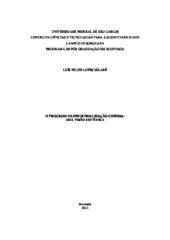O processo de industrialização chinesa: uma visão sistêmica
Resumen
The main objective of this dissertation is to present an interpretation of the Chinese industrialization and to show how China was able to transform its productive structure. To do so, first it is presented the bases of the industrialization process: the Mao Zedong s era (1949-1976). We argue that the economic reforms introduced by Mao Tsé-Tung helped underpin the success obtained by Deng Xiaoping after 1978 (the period of greater dynamism). After that, we analyze the most dynamic period of the Chinese economy: Deng Xiaoping s reforms. We argue that the great growth experienced in this period was motivated by very high State investments. The fast industrialization was based in a strategy of Governmental autonomy; indirect control of the productive and financial structure; and planning of solid industrial policies. Finally we make a detailed analysis of the transformation of the Chinese industrial structure. Through this analysis we see that the Chinese industrial structure has advanced to more dynamic and complex segments more intensive in technology. Thus, we conclude that the Chinese strategy of industrialization was based on autonomy, planning and control with State leadership which allowed them to transform its industrial structure. This transformation was stimulated by high investments that speeded China s industrial catching-up.
